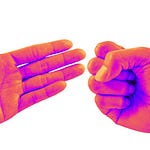When there’s too much of nothing
No one has control
Bob Dylan
Picture this scene.
You walk into a local fast-food chain franchise for lunch. You know, the one in which the burger is king. The teenaged automaton behind the counter mechanically asks what you will have. On the menu board you see there is a new item listed: the IllusoryBurger™️. You are trying to watch your weight, and this IllusoryBurger™️ is advertised with surprisingly few calories. So, in the spirit of culinary adventurism, you announce boldly, “I wanna try that new IllusoryBurger™️.”
The teenaged bot confirms your order: “That is one IllusoryBurger™️.”
“Yup, I want a IllusoryBurger™️,” you repeat. But doubt creeps in quickly. Would a single IllusoryBurger™️ really be enough? “No wait,” you say. “I’ll have the Double IllusoryBurger™️.” Then, as if inspired, you add, “with cheese!”
The teenager doesn’t flinch before reciting, “For just 85 cents more you can have the Double IllusoryWhopper™️ with cheese.” The suggestion is so automatic you might as well be conversing with an algorithm.
“Oh, okay. Give me that,” you reply thoughtlessly, mesmerized by the teenbot’s machine-like drone.
In almost no time, you are taking your sandwich to an open table and unwrapping it. It looks delightful, that big bun so jam-packed that you can barely open your mouth wide enough to take a bite. As you lift it toward your face, a glob of moist mayo leaks from the back, lettuce juts out at screwy angles, an onion slice peeks from inside, a pickle chip threatens to abandon ship, tomato glistens red, a dollop of melted cheese dangles like an uvula in space. Scrumptious. Then, just two bites into your delicacy you realize that the IllusoryWhopper™️ is little more than a nothing burger. You have purchased a large — luxurious even — sesame seed bun jammed with mayo, lettuce, onion, pickle, tomato, and melted cheese, and that’s it.
Should you go up to the counter to complain? You did, after all, order the Double IllusoryWhopper™️ with cheese. You decide to settle in and content yourself with your big bun filled with veggies and goop and call that lunch.
The next day, you go back, and the same pimply adolescent behind the counter says, “would you like another Double IllusoryWhopper™️ with cheese today? You seemed to really enjoy it yesterday.” What happened to the teenbot from the day before? This kid now seems capable of passing the Turing test.
Of course, you would prefer your burgers to consist of physical matter. Then again, you are watching your weight, and the IllusoryBurger™️ has very few calories. Besides, you don’t want to look like you didn’t know what you were ordering yesterday. You purchase another Double IllusoryWhopper™️ with cheese and retreat back to your favorite table. The bun is so big, and there is so much lettuce and mayo and melted cheese, not to mention the fat tomato slice. This sandwich might as well be the regular Whopper. After all, it looks just like the Whopper. And thus the delusion sets in to take hold as you blithely chow down on next to nothing.
It’s a silly tale, I know. After all, it’s hard to imagine a fast-food chain serving such a nonnutritious and insipid item. And my parable is a little overstuffed, but I trust it is still digestible. Perhaps it reminds you of times in your workplace when you have had to swallow something just as utterly bereft of meat.
How often have you witnessed a frenzied colleague churning away at a problem that was not discernibly or appreciably challenging or even important? How many times have you been caught up in a miasma of meaninglessness, processing pointlessly redundant forms and generating report after report that no one will ever read let alone act on? Why?
This story is about the workplace nothing burger — mindless toil, endless busywork, and superfluous drudgery — being whipped up into a big, fat Whopper to be served hot and gobbled down on a daily basis.
In fact, we all do this. We maximize the significance of whatever is in front of us even when it is really not a big deal. We conflate urgency with importance, which scrambles our ability to set and maintain priorities. Former president Dwight D. Eisenhower had an elegant way of sorting out this muddle. The Eisenhower matrix is a handy tool for setting priorities within a simple framework.
The idea is that you assess each decision or project on the basis of its urgency (its need to be done soon) and its importance (its value to you and to your work in the future). The matrix is divided into four quadrants with four descriptors. The best place to operate is in quadrant 2 (important and not urgent) where your work has the highest value with the least pressure. The best bosses assure that their people are operating in quadrant 2 as much as possible. Quadrant 1 (important and urgent) is for critical items with imminent deadlines and for true crises.
Bad bosses are the ones who frequently elevate quadrant 3 (not important and urgent) and quadrant 4 (not important and not urgent) to the level of quadrant 1 and regularly turn minor and meaningless work into emergencies. The worst bosses are the ones who operate almost exclusively in quadrant 1 and treat everything as a catastrophe. The thing is, if everything is a crisis, nothing is a crisis. In other words, viewing everything as most urgent and important means that there is no baseline for setting priorities and no differentiation of tasks. I wrote about the relationship between crisis thinking and perfectionism some time back.
By definition, crises should be exceptional, not the norm. That’s what distinguishes a crisis as a crisis and not just as a setback or a challenging task. When I was a university dean, I grew so tired of hearing about false and overblown crises that I all-but banned the word. I told my people to think before they used the word “crisis” or any of its synonyms and to decide if what they were facing was really a crisis. The result? The occurrence of crisis thinking in our school rapidly dissipated, and we were then better able to prioritize. Amazingly, we soon found that many matters that had seemed crucial and that consumed our time were no big deal at all and could be easily dispensed with. Meanwhile, I watched other administrators continue to convert such nothing burgers into Whoppers, Double Whoppers, and even Triple Whoppers. Their entire mental menu was Whoppers with nary even a Whopper, Jr. in sight.
The funny thing is that because these connoisseurs of nothing burgers were constantly active, chomping down on air, they gave the impression that they were fantastically effective. They were not. These other administrators, though, regularly received accolades for all their restive exertion even as their people wilted like lettuce on a day-old hamburger. I wrote about the disproportional relationship between effort and quality in an essay entitled, “But I Worked So Hard on It!”
You see, the temptation to convert nothing burgers into Whoppers can have its own rewards. Hard work in some workplaces will masquerade as good work just as nothing burgers from my imaginary restaurant masquerade as flame-broiled all-beef patties. Poor leaders regard hard work as an end in itself. If you are stuck in a place where you are forced to consume endless meals of nothing burgers, there is good news, though. Even after you gorge yourself on a bunch of nothing burgers, you will still have plenty of room for fries and a large fountain soft drink.
Bon appetit!
Is your work culture rife with catastrophic thinking, poor priority setting, and overwork? How can you best apply the Eisenhower matrix and other tools to your daily work and use them to lead others?
You can set more productive priorities and work better without necessarily working harder, and I can help. Click below for your free consultation.
Share your thoughts on this topic or participate in a discussion by leaving a comment below or by contacting me directly by email:
You must register with Substack and sign in to leave a comment, which is painless and free.
Please share this post on social media.
And don’t forget to click subscribe to have Tools+Paradigms sent directly to your inbox. I look forward to hearing from you.


















Share this post